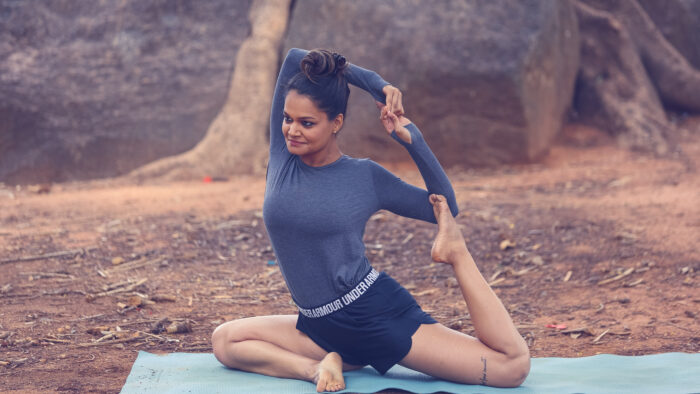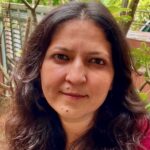Bangalore-based yoga teacher and author, Pragya Bhatt, has lived in 11 cities across seven continents, and while she loves how various cultural experiences enriched her life, she chose yoga and Indian culture as the subject for her first book, Beyond Asanas. This book traces the mythological origins of various asanas from Hatha yoga and Pragya deconstructs each pose in terms of how it got its name (whether based on animals, nature, a sage…) and how it affects us during physical practice. Indica Yoga caught up with Pragya to discuss her love for writing, travel and exploring all things yoga…
Sophia: Why did you decide to start practising and teaching yoga?
Pragya: I started practising yoga because I was overweight and had been trying various forms of movement and unhealthy diets to lose weight. At the time (around 2009) power yoga had become Bollywood’s favourite weight loss methodology, and I (like many others) quickly jumped on the bandwagon.
Teaching yoga happened much, much later. I think I was deeply unhappy with the way my life was at the time I found yoga. I had a good, stable, well-paying job and worked with some great people, but my work wasn’t fulfilling. I couldn’t find any meaning or impact in the work and it was influencing my feelings about myself and my life. Even my quest to lose weight felt shallow. I think all these factors were the major contributing factors.
When I started practising yoga, Bangalore was experiencing the beginning of the startup era. So it was a time for change and for trying new things, and a lot of my yoga teachers were people who had jumped from stable and well-paid jobs to teaching yoga. I could relate to them, and I found them inspiring. Despite this, it would be another few years before I started to actually teach. I joined a regular yoga class in 2009, got certified from SVYASA in 2011 and started teaching anyone who would let me soon after that. I would say I gained a strong footing only in 2014.
Sophia: What are the core values of the way yoga is taught at SVYASA (Swamy Vivekananda Yoga Anusudhana Samsthana)?
Pragya: SVYASA aims to teach yoga and spirituality as propounded by Swami Vivekananda. There is a strong emphasis on Indian culture, values and history at the university. Going there for my YIC (Yoga Instructor’s Course) in 2011 steered me in the right direction. I realised it was my good fortune to be living in the country which has yoga in its DNA. I realised yoga is a living tradition here, and I decided I would do whatever it took to be a part of it. I believe this resolution was made in the SVYASA campus back in 2011.
Sophia: What inspired you to write your first book, ‘Beyond Asanas: The Myths and Legends Behind Yogic Postures’?
Pragya: Becoming a published author with the world’s oldest and most famous publishing house was the first and only dream I’ve ever had. I’ve been writing stories since I’ve learned how to write. In 1997, when Arundhati Roy won the Booker Award, I told my mom that I was going to be like Arundhati Roy. When I was working in Infosys, I was writing a book about a girl who worked in Infosys but didn’t really want to. When I was new to Bangalore, I was writing a blog about the great things you can do in Bangalore. So I’ve always been writing. It felt quite natural to me to think about writing about yoga. The question was — what should I write about? And soon that also became evident because the deeper I went into yogasana, the more I got interested in the cultural context of yoga and there were very few books about that which weren’t heavily academia laced. There were experts in Indian culture and indologists or historians that were writing about folklore and mythology but there wasn’t anything specific to yoga. That was the kind of stuff I wanted to read about, so I decided to do the research and write it myself.
Sophia: Why does one need to know about the myths behind yoga postures and how is it related to asana practice?
Pragya: When I initially started asana practice, I was enamoured just by the possibility of becoming so fit that I could one day twist and bend and balance on my hands. But one day I realised that I wasn’t only experiencing physical changes, I was also changing as a person. I realised I had more clarity of thought, and a sense of stability that I didn’t have prior to yoga practice. And in asana class, you’re always told that these changes will happen, but you’re never told why. The answer to why this happens is found in the literature and cultural background of the practice. Remember, yoga wasn’t meant to be only about asana practice, it is a holistic method of self enquiry. And the way we’re taught to think is through stories, experiences, fables, legends etc. All Indian practices (dance, martial arts, music, etc) are steeped in tradition, and yoga is the same. So having an understanding of these myths, stories and legends serves to contextualise yogasana practice within the framework of your life.
Sophia: On your website, you say you spend your free time trying to decode the Yoga Sutras of Patanjali. Can you elaborate on that?
Pragya: When I first started studying the Sutras, I understood only what the words meant. When I continued studying them, I started to understand the meaning. Now I’m working on understanding how the Sutras are relevant to our lives today, on and off the mat.
Sophia: What are you reading right now?
Pragya: I’m always reading several things at a time. So at the moment:
- For the Love of God: Women Poet Saints of the Bhakti Movement by Sandhya Mulchandani
- From Death to Birth by Pandit Rajmani Tigunait
- The Bangalore Detectives Club by Harini Nagendra
- Before the Coffee Gets Cold by Toshikazu Kawaguchi
- Creativity, Spirituality & Making a Buck by David Nichtern
I’m a moody reader, so I need something for all my moods.
Sophia: As you love to travel, what are your favourite yoga experiences in india?
Pragy: My annual pilgrimage (suspended at the moment due to the pandemic) to RIMYI, Pune tops the list. I spent 15 days at KPJAYI in 2015 and enjoyed that immensely. I remember attending a chanting class and visiting the Somnathpur temples at the time. I also interacted with many serious Ashtanga practitioners and got invaluable insight into the lineage. On a recent trip to Shravanabelagola, I had the opportunity to visit NIPSAR — The National Institute of Prakrit Study and Research where I had the good luck to see many ancient manuscripts - it was also a very special trip for me.
Sophia: What makes a good yoga student and when should a student think about becoming a teacher?
Pragya: A good yoga student is one who commits to the practice humbly, and for the long haul. A good student spends a significant amount of time on self-practice and self-study. Good students seldom indulge in ‘teacher-hopping’ and they remember that this practice requires time and patience.
Sophia: Name a few Indian spiritual masters that inspire you and your spiritual journey?
Pragya: Yogacharya B.K.S. Iyengar inspires me the most. Not a day goes by that I don’t read a quote or a passage by him. Smt. Geeta Iyengar inspires me as well - I had the good fortune to attend one of her classes in Pune and the only word I can use to describe it is ‘magical’.
I’m inspired by my Vedanta teacher, Smt Subhadra Devi.
I’m also inspired by Bhakti poets such as Andal and Mira bai — who have changed society not by violent opposition to the status quo - but through the strength, courage and dignity that I believe is inherent in femininity.
Sophia: Any words of advice?
Pragya: Persevere and it’ll work itself out.
For more information on Pragya, visit Yoga With Pragya.





